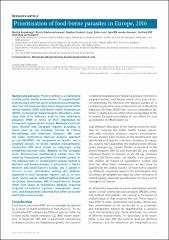| dc.contributor.author | Bouwknegt, Martijn | |
| dc.contributor.author | Devleesschauwer, Brecht | |
| dc.contributor.author | Heather, Graham | |
| dc.contributor.author | Robertson, Lucy J. | |
| dc.contributor.author | van der Giessen¹, Joke WB | |
| dc.contributor.author | Petrović, Jelena | |
| dc.date.accessioned | 2019-10-31T13:33:52Z | |
| dc.date.available | 2019-10-31T13:33:52Z | |
| dc.date.issued | 2018-03 | |
| dc.identifier.citation | Bouwknegt Martijn, Devleesschauwer Brecht, Graham Heather, Robertson Lucy J, van der Giessen Joke WB, the Euro-FBP workshop participants. Prioritisation of food-borne parasites in Europe, 2016. Euro Surveill. 2018;23(9):pii=17-00161. https://doi.org/10.2807/1560-7917.ES.2018.23.9.17-00161 | en_US |
| dc.identifier.issn | 1560-7917 | |
| dc.identifier.uri | https://repo.niv.ns.ac.rs/xmlui/handle/123456789/73 | |
| dc.description.abstract | Priority setting is a challenging task for public health professionals. To support health professionals with this and in following a recommendation from the Food and Agriculture Organization of the United Nations (FAO) and World Health Organization (WHO), 35 European parasitologists attended a workshop from 8–12 February 2016 to rank food-borne parasites (FBP) in terms of their importance for Europe and regions within Europe. Methods: Countries were divided into European regions according to those used by the European Society of Clinical Microbiology and Infectious Diseases. We used the same multicriteria decision analysis approach as the FAO/WHO, for comparison of results, and a modified version, for better regional representation. Twenty-five FBP were scored in subgroups, using predefined decision rules. Results: At the European level, Echinococcus multilocularis ranked first, followed by Toxoplasma gondiiand Trichinella spiralis. At the regional level, E. multilocularis ranked highest in Northern and Eastern Europe, E. granulosus in SouthWestern and South-Eastern Europe, and T. gondii in Western Europe. Anisakidae, ranking 17th globally, appeared in each European region’s top 10. In contrast,
Taenia solium, ranked highest globally but 10th for Europe. Conclusions: FBP of importance in Europe differ from those of importance globally, requiring targeted surveillance systems, intervention measures, and preparedness planning that differ across the world and across Europe. | en_US |
| dc.description.sponsorship | This work was a collaboration within the framework of Euro-FBP, the European Network for Foodborne Parasites, COST Action FA1408. | en_US |
| dc.language.iso | en | en_US |
| dc.source | Eurosurveillance | en |
| dc.title | Prioritisation of food-borne parasites in Europe, 2016 | en_US |
| dc.type | Article | en_US |
| dc.identifier.doi | 10.2807/1560-7917.ES.2018.23.9.17-00161 | |

